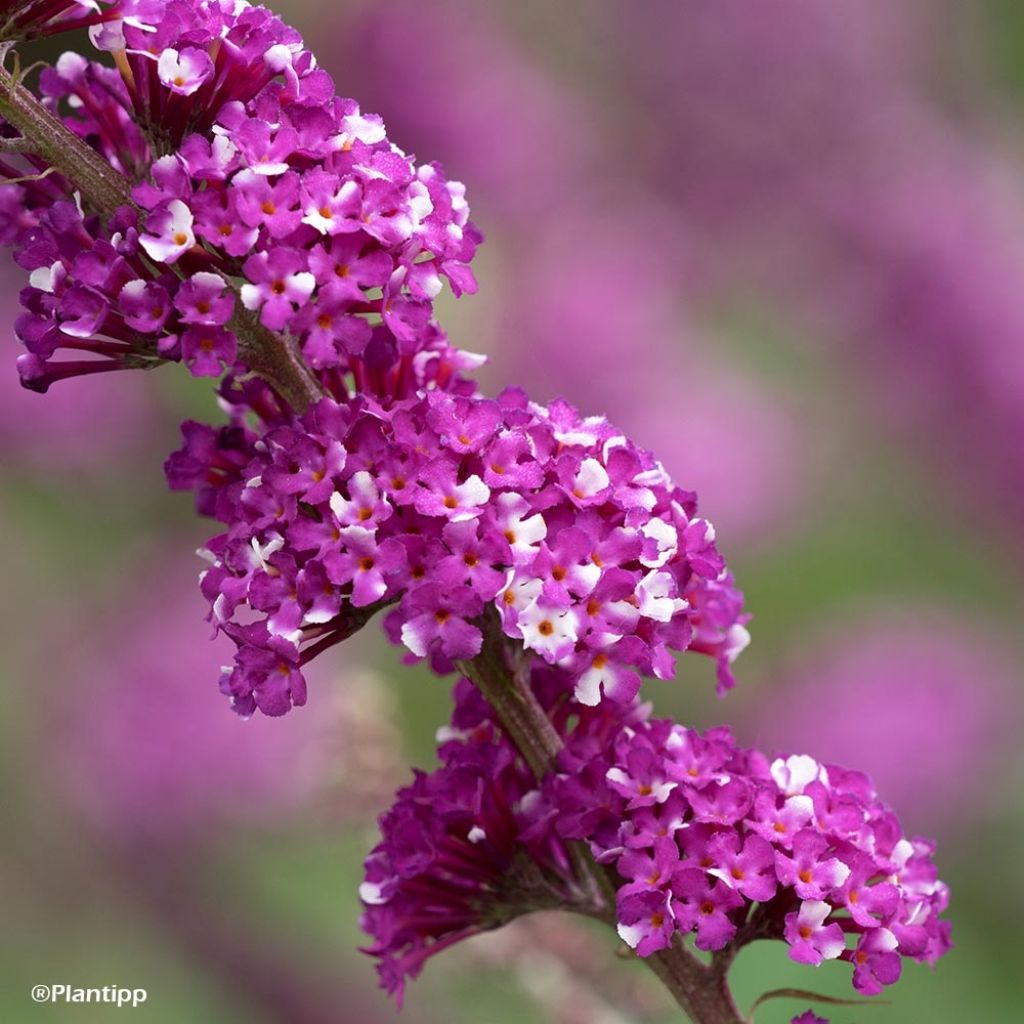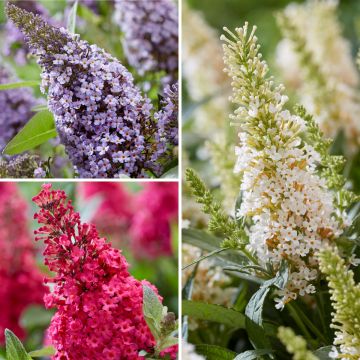

Buddleja davidii Berries and Creamv


Buddleja davidii Berries and Creamv


Buddleja davidii Berries and Creamv
Buddleja davidii Berries and Creamv
Buddleja davidii Berries and Cream ('PMOORE14')
Butterfly Bush, Summer Lilac
Ordered in October 2022, during the summer of 2023 the flowers had a lovely variegated purple and white appearance just like in the photos. However, this year (2024), the flowers are solid purple without a single spot of white. Apart from that, the young plant is healthy and very vigorous.
Stephane, 26/06/2024
Special offer!
Receive a €20 voucher for any order over €90 (excluding delivery costs, credit notes, and plastic-free options)!
1- Add your favorite plants to your cart.
2- Once you have reached €90, confirm your order (you can even choose the delivery date!).
3- As soon as your order is shipped, you will receive an email containing your voucher code, valid for 3 months (90 days).
Your voucher is unique and can only be used once, for any order with a minimum value of €20, excluding delivery costs.
Can be combined with other current offers, non-divisible and non-refundable.
Why not try an alternative variety in stock?
View all →This plant carries a 24 months recovery warranty
More information
We guarantee the quality of our plants for a full growing cycle, and will replace at our expense any plant that fails to recover under normal climatic and planting conditions.
Would this plant suit my garden?
Set up your Plantfit profile →
Description
Buddleia davidii Berries and Cream ('PMOORE14') is a new variety of bush with an undeniable originality. Its long spikes are composed of a profusion of small bi-coloured flowers in purple-violet and cream-white shades. This deciduous bush with an upright habit offers a delightful spectacle from July to September. Highly appreciated by butterflies, this variety is also hardy. It will thrive in ordinary, well-drained soil in full sun. It will be truly magnificent when planted alone or in a flowering hedge.
Buddleia davidii Berries and Cream ('PMOORE14') was created in England in 2018 by Peter Moore. This variety was extensively selected from a bi-coloured flower discovered on a Buddleia davidii 'Royal Red' plant. Like its excellent parent, Berries and Cream is a deciduous to semi-evergreen bush belonging to the Scrophulariaceae (buddleja) family.
The bush has an upright habit, reaching an average height of 2.5 m (8. ft) with a spread of 1 m (3.3 ft) in 7 or 8 years, depending on the growing conditions. It blooms from July to September with an abundance of 15 cm to 20 cm (5.9 in to 7.9 in) long flower panicles, which are dense. These generally bi-coloured flowers are purple-violet and cream-white, punctuated with a red-orange eye. Some flowers can be entirely white or purple. They release a sweet fragrance, which is attractive to pollinating insects. Its ornamental foliage is composed of long, dark green leaves, with a greyish fuzz on the underside. The leaves, 15 cm to 25 cm (5.9 in to 9.8 in) long, are pointed and lanceolate. This hardy bush is resistant to urban pollution and does not suffer from occasional drought in deep soil.
Whether planted alone or in groups, in a hedge, at the corner of a patio or at the back of a perennial border, Buddleia davidii Berries and Cream will enhance the garden in a unique way. Its harmonious inflorescences animated by a constant flight of butterflies are a spectacle in themselves. They also highlight the mauve and white panicles of some summer lilacs. You can plant it in a mixed hedge, with botanical roses, serviceberries, hawthorns, ornamental apple trees or flowering cherries. It adapts well to coastal areas and can be grown in containers. Its fragrant flowers are also very attractive in bouquets. For an elegant contrast, plant this Butterfly Bush with tall grasses like Miscanthus, Panicum, Deschampsia.
Remove faded flowers as they appear to encourage the formation of secondary inflorescences, and prune quite severely from March to April.
Buddleja davidii Berries and Creamv in pictures


Plant habit
Flowering
Foliage
Botanical data
Buddleja
davidii
Berries and Cream ('PMOORE14')
Buddlejaceae
Butterfly Bush, Summer Lilac
Cultivar or hybrid
Other Buddleja -Butterfly bush
View all →Planting and care
Buddleia davidii Berries and Cream is easy to grow, as it is a low-maintenance plant when it comes to soil. It enjoys sunny spots, but also flowers in partial shade. Plant it in spring or early autumn, in ordinary soil, even chalky and mediocre, but well-worked, well-drained, and deep. Once well established, the plant can withstand periods of moderate drought. David's buddleia has no significant enemies. However, beware of caterpillars, weevils, bugs and red spider mites that can invade it. Pruning after each wave of flowering and/or in early spring keeps the habit ramified and compact and encourages the bush to produce numerous flowers.
Planting period
Intended location
Care
Planting & care advice
-
, onOrder confirmed
Reply from on Promesse de fleurs
Similar products
Haven't found what you were looking for?
Hardiness is the lowest winter temperature a plant can endure without suffering serious damage or even dying. However, hardiness is affected by location (a sheltered area, such as a patio), protection (winter cover) and soil type (hardiness is improved by well-drained soil).

Photo Sharing Terms & Conditions
In order to encourage gardeners to interact and share their experiences, Promesse de fleurs offers various media enabling content to be uploaded onto its Site - in particular via the ‘Photo sharing’ module.
The User agrees to refrain from:
- Posting any content that is illegal, prejudicial, insulting, racist, inciteful to hatred, revisionist, contrary to public decency, that infringes on privacy or on the privacy rights of third parties, in particular the publicity rights of persons and goods, intellectual property rights, or the right to privacy.
- Submitting content on behalf of a third party;
- Impersonate the identity of a third party and/or publish any personal information about a third party;
In general, the User undertakes to refrain from any unethical behaviour.
All Content (in particular text, comments, files, images, photos, videos, creative works, etc.), which may be subject to property or intellectual property rights, image or other private rights, shall remain the property of the User, subject to the limited rights granted by the terms of the licence granted by Promesse de fleurs as stated below. Users are at liberty to publish or not to publish such Content on the Site, notably via the ‘Photo Sharing’ facility, and accept that this Content shall be made public and freely accessible, notably on the Internet.
Users further acknowledge, undertake to have ,and guarantee that they hold all necessary rights and permissions to publish such material on the Site, in particular with regard to the legislation in force pertaining to any privacy, property, intellectual property, image, or contractual rights, or rights of any other nature. By publishing such Content on the Site, Users acknowledge accepting full liability as publishers of the Content within the meaning of the law, and grant Promesse de fleurs, free of charge, an inclusive, worldwide licence for the said Content for the entire duration of its publication, including all reproduction, representation, up/downloading, displaying, performing, transmission, and storage rights.
Users also grant permission for their name to be linked to the Content and accept that this link may not always be made available.
By engaging in posting material, Users consent to their Content becoming automatically accessible on the Internet, in particular on other sites and/or blogs and/or web pages of the Promesse de fleurs site, including in particular social pages and the Promesse de fleurs catalogue.
Users may secure the removal of entrusted content free of charge by issuing a simple request via our contact form.
The flowering period indicated on our website applies to countries and regions located in USDA zone 8 (France, the United Kingdom, Ireland, the Netherlands, etc.)
It will vary according to where you live:
- In zones 9 to 10 (Italy, Spain, Greece, etc.), flowering will occur about 2 to 4 weeks earlier.
- In zones 6 to 7 (Germany, Poland, Slovenia, and lower mountainous regions), flowering will be delayed by 2 to 3 weeks.
- In zone 5 (Central Europe, Scandinavia), blooming will be delayed by 3 to 5 weeks.
In temperate climates, pruning of spring-flowering shrubs (forsythia, spireas, etc.) should be done just after flowering.
Pruning of summer-flowering shrubs (Indian Lilac, Perovskia, etc.) can be done in winter or spring.
In cold regions as well as with frost-sensitive plants, avoid pruning too early when severe frosts may still occur.
The planting period indicated on our website applies to countries and regions located in USDA zone 8 (France, United Kingdom, Ireland, Netherlands).
It will vary according to where you live:
- In Mediterranean zones (Marseille, Madrid, Milan, etc.), autumn and winter are the best planting periods.
- In continental zones (Strasbourg, Munich, Vienna, etc.), delay planting by 2 to 3 weeks in spring and bring it forward by 2 to 4 weeks in autumn.
- In mountainous regions (the Alps, Pyrenees, Carpathians, etc.), it is best to plant in late spring (May-June) or late summer (August-September).
The harvesting period indicated on our website applies to countries and regions in USDA zone 8 (France, England, Ireland, the Netherlands).
In colder areas (Scandinavia, Poland, Austria...) fruit and vegetable harvests are likely to be delayed by 3-4 weeks.
In warmer areas (Italy, Spain, Greece, etc.), harvesting will probably take place earlier, depending on weather conditions.
The sowing periods indicated on our website apply to countries and regions within USDA Zone 8 (France, UK, Ireland, Netherlands).
In colder areas (Scandinavia, Poland, Austria...), delay any outdoor sowing by 3-4 weeks, or sow under glass.
In warmer climes (Italy, Spain, Greece, etc.), bring outdoor sowing forward by a few weeks.


































































